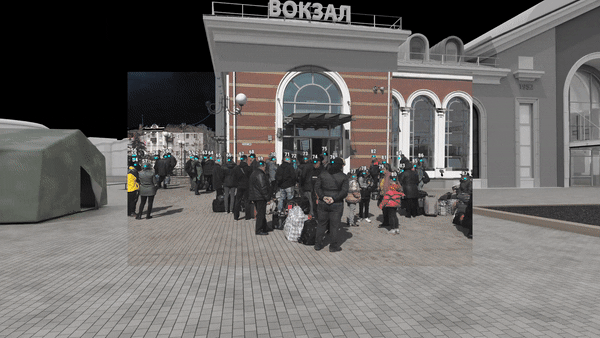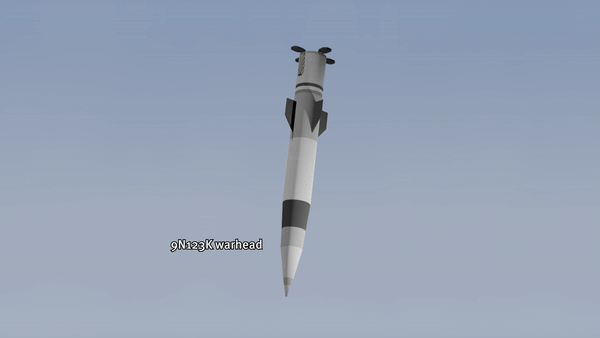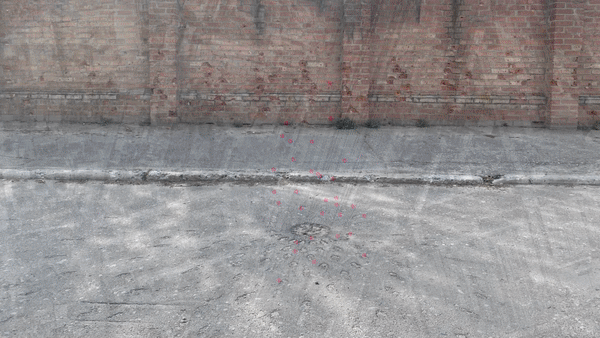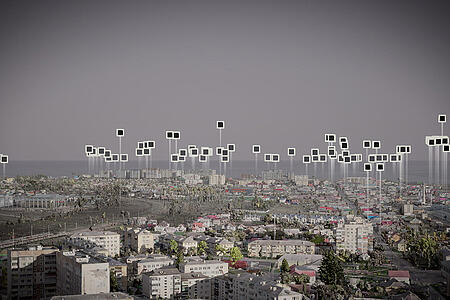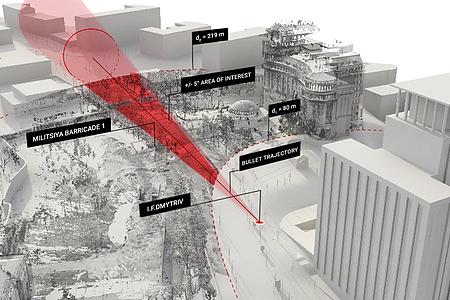Death at the Station: Russian Cluster Munition Attack in Kramatorsk, Ukraine
A Russian Cluster Munition Attack on the Kramatorsk Train Station in Eastern Ukraine.
Collaborators:
Human Rights Watch
Location:
Kramatorsk, Ukraine
Completion:
2023
On April 8, 2022 at 10:28am, a Tochka-U missile equipped with a cluster munition warhead dropped fifty small bombs, known as submunitions, over the train tracks and station in Kramatorsk, Ukraine. The attack, which appears to have been launched from Russian-controlled territory in eastern Ukraine, remains one of the deadliest single incidents for civilians since Russia’s full-scale invasion of Ukraine began on February 24, 2022.
SITU Research and Human Rights Watch (HRW) analyzed the impact of this fatal strike that killed and injured dozens of people who were evacuating Kramatorsk. "Death at the Station: Russian Cluster Munition Attack in Kramatorsk” is a new investigation that reconstructs the sequence of events surrounding the attack, and combines witness testimony, video documentation capturing before and after the strike, and a performance-based weapons analysis. By situating the evidence within a 3D model of the Kramatorsk Train Station and its surrounding area, our research teams were able to establish that the strike was an indiscriminate and disproportionate attack on civilians and civilian infrastructure. A comprehensive, investigative report with additional details can be accessed here.
Methodologies
Under the Geneva Conventions Additional Protocol I (1977) and by customary international law, an indiscriminate attack is characterized when “an attack disproportionately causes civilian loss of life, damage, or injury, which would be excessive in relation to the tangible and direct military advantage anticipated.”
Using footage from journalists who were documenting the evacuations, as well as videos captured by civilians, we assessed footage from April 8 taken at various vantage points: the train’s platform, the interior of the station, and those already located on the train. We then synched the movement of people with numbers, which allowed us to confirm that over 500 people were present at the time of the attack. Establishing this headcount was essential for corroborating the fact that the station was populated with civilians who were attempting to evacuate. While train tracks can indeed be legitimate military targets due to their use for military transportation, the Kramatorsk Train Station was being used as a central hub for those fleeing Kramatorsk.
To illustrate the bomb’s lethal consequences, we conducted a performance-based analysis of the Tochka-U coupled with a splatter analysis in order to show how each warhead indiscriminately disperses 50 9N24 fragmentation submunitions. We cross-referenced video and photographic documentation from five distinct locations near the train’s platform–areas that were struck by the submunitions. This allowed us to trace the pattern set off by each submunition.
Specifically, we estimated the minimum radius of how each submunition impact falls in order to show the wide area of coverage. Because footage of the moments the Tochka-U’s submunitions striking the rail station were not available, we assembled a simulation demonstrating the basic principle of how the 50 submunitions combine to cover an area approximate to the size of a football field. Anything within this area should be considered indiscriminate, especially when deployed in densely populated civilian areas.
Moving between different scales of impact–from aerial footage to X-ray documentation of injured bodies–the video reconstruction makes clear that this weapon has devastating effects when used against both structures and civilians. The excerpted sequence below features the X-rays provided to HRW by a hospital in Kramatorsk, showing victims with metal fragments consistent with the same size and shape of those from the 9N24 submunition.
Point of Origin
One challenge our researchers faced was verifying conclusive evidence of the weapon’s attribution, or provenance. However, in the middle of the investigation, HRW uncovered new information that the Tochka-U missile was stored and possibly deployed near a facility in Kunie, Ukraine, which at the time of the attack, was under Russian control.
Using satellite footage, witness testimony from local residents and photographs, evidence revealed that the Tochka-U missile containers were present at the time of the attack, as well as remnants left over from the weapon’s launch. Satellite footage from April 6, two days prior to the attack, shows smoke plumes and fires set by the missile launcher--characteristics that matched the Tochka-U. Additionally, the distance between the Kramatorsk Train Station and Kunie falls within the 120km/75m range of the missile’s reach. Taken together, this evidence strongly supports the claim that Kunie was a possible launch location.
Accountability
The Russian government not only denied their involvement in the train station bombing on April 8, but they also purported that the Tochka-U weapon had been removed from service in 2019.
Days and weeks prior to the attack, the station was being used to transport thousands of people–movement that would have been visible in satellite footage, which suggests that Russian officials ought to have known that civilians were likely to be at the station that morning. Although train tracks qualify as military targets if they are being used for military purposes, the station was clearly being used as an evacuation hub that morning. While the Ukrainian military was stationed 350 meters southwest of the train station, there is not conclusive evidence that these forces were nearby on the day of the attack.
The video reconstruction and investigative report demonstrate how the use of the Tochka-U is by default an indiscriminate weapon. While it is banned under the 2008 Convention on Cluster Munitions, neither Russia nor Ukraine are a part of this treaty. Our hope is that the evidence put forth shows that the attack was a war crime and that those responsible need to be held to account.
To read our joint press release, see here.
Video analysis and interactive website acknowledgements:
Research at Human Rights Watch by: Richard Weir, Alexx Perepölov, Belkis Wille, Kseniya Kvitka, Yuri Kulynyak, Ida Sawyer, Robin Taylor, Gabriela Ivens, Devon Lum, Léo Martine, Carolina Jordá Álvarez, Martyna Marciniak, Sam Dubberley, Mark Hiznay
Research at SITU Research by: Bora Erden, Jarrett Ley, Helmuth Rosales, Brad Samuels, Candice Strongwater
Legal analysis by: James Ross
Reviewed by: Fred Abrahams, Rachel Denber, Yulia Gorbunova
Editorial and production coordination by: Nia Knighton and Emma Wilbur
Web design by: Grace Choi and John Emerson
Video production by: Taurai Maduna
Architectural model of Kramatorsk Train Station courtesy of Architecture bureau VALENTIROV&PARTNERS / http://valentirov.com/en/

